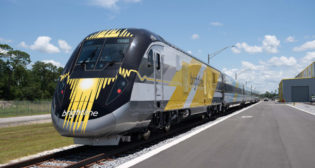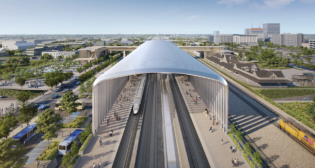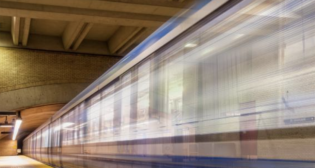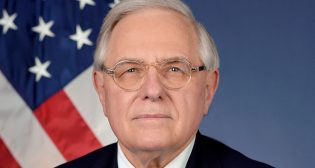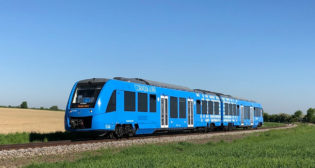
Al Engel: “A learned passion—each train wreck has a story and a lesson”
Written by William C. Vantuono, Editor-in-ChiefRemarks by 2014 W. Graham Claytor Jr. Award for Distinguished Service to Passenger Transportation recipient Al Engel at Railway Age’s 21st Passenger Trains on Freight Railroad Conference, Oct. 29, 2014.
Thank you Bill [Vantuono], for that generous introduction and whatever you may have had to do with influencing my selection for this award. My congratulations to you and the Railway Age team for your 21st anniversary of this conference. The conference has become a staple in our industry for knowledge acquisition and networking.
I am humbled and honored to be selected for this recognition and accept the award on behalf of all those co-workers, mentors, and role models who helped me or inspired me along the way. I also want to recognize my wife, Nancy, for her general support and tolerance of my spending many weekends at various conferences advocating for a more balanced surface transportation policy.
I have little in common with the namesake for this award, except we both worked for Amtrak and have a passion for the importance of passenger rail. I am hardly in the same league as Graham Claytor, Jr. I was in the business at the time of his Amtrak tenure and have a great respect for Claytor’s leadership and am well aware of his lifetime achievements and his contributions to save and improve Amtrak. I can only hope to achieve a small measure of what he did for our industry.
I was asked to make some remarks but given no guidance on the topic. There isn’t much I can tell you about railroading you don’t already know, so I thought I would tell you why I believe in miracles and life after death. And no, this is not a religious sermon. First I’ll tell you some secrets about my personal evolution and then move on to the miracles and close with a view to the future.
My father helped ignite the engineering interest in me. He was an innovative machinist who learned his craft as an apprentice with the Deutsche Bundesbahn (German Federal Railway). He believed in education and continuous self-improvement and was somewhat of an adventurer. When I was only six years old, he decided the family would be better off in the United States and emigrated from Munich, Germany. It turned out to be an adventure for me too, especially starting first grade without any knowledge of the English language.
Within a couple of years my father saved enough money to make a down payment and get a mortgage to purchase a very old farmhouse. It needed a lot of work and didn’t even have a bathroom, but there was an upside in his eyes. It had an extra room that could be used as a “train room.” It wasn’t long before I was drafted into his HO scale model railroading brigade along with my two sisters. I was also given the one choice of KIX cereal for breakfast every morning, so he could collect enough box tops to acquire an HO rail equipment fleet.
We lived out in Pennsylvania dairy country with not a railroad in sight. So my father would make the 45-mile trek with me into Philadelphia on some weekends to ride the Broad and Market Street subways along with what was then known as the Norristown High Speed Line. To his disappointment though, when I began my engineering studies at Penn State in the fall of 1964, I was determined to major in the technical field of the future–electronics/computers. I also had a desire to become an Air Force pilot.
While I vaguely recall a few news stories on the launch of the Japanese Bullet trains in that fall of 1964, it did not really enter my consciousness that a new era of transportation was dawning. In January 1965 of my freshman year, Lyndon Johnson in his State of the Union address promised us a national high speed rail program with the words, “I will ask for funds to study high speed rail transportation between urban centers. We will begin with test projects between Washington and Boston. On high speed trains, passengers could travel this distance in less than four hours.”
But that did not enter my consciousness either. Little did I realize then that engineering, public transit, and passenger rail systems would become much of my life’s work.
When I was in my senior year at Penn State, I truly was “dead broke.” I had gone through all my savings from summer jobs plus accumulated several thousand in debt. So when applying for my first engineering job, money was important. Even though I had offers from a number of sexy aerospace companies located in much better climates, GE in Erie offered the best starting salary. And there began my railroad career.
After a two year engineering training program with six month rotating assignments, in June 1970 I started my first permanent assignment in the newly created Railroad Electrification Business Line in the Locomotive Department. We were open for business in any markets available to us, which in practically limited us to North and South America and developing nations. Europe and Japan as well as the Communist Block were essentially closed markets.
We built on the relationships with our Class I diesel locomotive customers to open dialogues on main line electrification projects. We came very close to a project launch on the Southern Pacific’s Colton to El Paso line and a few others. Well, you all know how that went.
We also looked internationally and noticed that Taiwan was electrifying its West Coast line. In February 1972, as a very young subject matter expert, I accompanied the Export Locomotive Sales Manager to do an investigation of the potential for our participation as locomotive supplier. We spent a good week there only to learn that the Germans were already selected. We decided that the opportunity was past and flew home to deliver the bad news to senior management.
A few months passed, and in May a telex message came in from GE’s Taiwan agent urging management to send a delegate to Taiwan to participate in the biennial Modern Engineering Technology Seminar running from late June through mid-July 1972. The agent saw this as a subtle opportunity to introduce our technology and systems approach to the railway managers who would be attending the conference. I believe I was selected because my managers saw this as a losing mission and had already made their summer vacation plans. No one asked me about my plans.
So in late June with presentation notes and slides in hand, I flew alone to Taiwan—a four-legged flight: Erie, New York, Fairbanks, Tokyo, and finally Taipei, some 30 hours later. It was a bit unnerving knowing that the Germans were in town negotiating the terms of the locomotive purchase with the Taiwan Railway Administration.
Most of the seminar participants were Chinese nationals who had distinguished themselves in their various technical fields working in the U.S. and came back to their homeland to share their knowledge and insights. There were about 10 technology sectors ranging from Transportation to Petrochemicals. I was one of only two Americans who couldn’t speak Chinese and probably the only speaker without a Ph.D. Living on a diet of traditional Chinese cuisine for the duration, I presented the GE electric locomotive technology story to whoever would listen. The pitch included the 50 KV overhead distribution concept developed for the 80-mile Black Mesa & Lake Powell coal hauling railroad in northern Arizona.
Shortly after my return, to our great surprise, our agent called to advise that the Taiwan Railway had decided to terminate their negotiations, cancel the procurement, and re-bid the project. After a protracted bidding process, GE was initially awarded a contract for 40 E42C locomotives; ultimately a total of 97 were purchased. They were 25KV, not 50.
I moved on to assume the project management role for Amtrak’s first passenger locomotive procurement, the E60CP. Amtrak wanted a universal design that could be configured in either a steam generator or electric head-end-power version with a maximum operating speed of 120 mph. And they wanted it immediately. After an accelerated design and production program of less than two years, we delivered several locomotives for testing in the fall of 1974, almost 40 years ago to the day. After field testing and design modifications were made in late ’74-early ’75, including 120 mph test runs on the Raceway north of Trenton, we were ready for the final acceptance test. It was on a cold and soggy winter morning on Feb. 24, 1975 that we left Philadelphia’s 30th Street Station late in the morning with the E60CP and eight coaches in tow, headed for Washington, D.C. We were all in a somewhat celebratory mood and confident that this 130 mile stretch would be the successful culmination of a long and arduous test program. I was looking forward to getting back with my wife and infant first daughter in Erie and no longer calling the Penn Center Inn my home.
But it was not to be. As we rounded a half-percent curve at 100 mph, approaching milepost 42 near Elkton, Md., the locomotive began vibrating excessively and in a moment, Joe Spring yelled out, “hit the floor!” There were 11 of us in the forward cab looking for space to crouch down. It took about 20 seconds to come to rest but it seemed like an eternity. The test train destroyed three tracks for about a half-mile. Fortunately a northbound high speed Metroliner was still miles away, so no collision. We were operating on Penn Central tracks that had deteriorated from years of deferred maintenance.
That was a profound message! An exclamation mark that we had flaws in our test program, there was a serious track deficiency, and possibly deficiencies in the locomotive design. So what at first seemed like a death knell for the program became an extended delivery delay. After an extensive wheel-rail dynamics test program, the E60CPs finally went into revenue service, but were limited to 90 mph.
I don’t think it was pure coincidence that the Railroad Revitalization and Regulatory Reform Act (4R Act) was passed a year later, transferring the NEC assets to Amtrak along with several states and providing a $2 billion budget to upgrade the NEC. And of course there have been many more billions invested in much-needed corridor improvements since the NECIP program, including the Acela Express initiative. That turned out to be a very good project for LS Transit Systems, the engineering firm I was building at the time. We were the general engineering contractor in a joint venture with Gannett Fleming.
But here we are 40 years after that infamous day, and while global high speed rail mileage in operation has grown beyond 14,000 miles, we are still asking, when will the U.S. will have a national policy and program for a world-class intercity passenger rail system? By posing this question I don’t mean to cast any aspersions upon Amtrak. I’ve had the pleasure of working there as a Vice President with many fine people both in the managerial and agreement ranks. Amtrak is fiscally and statutorily constrained and doing what it can in a politically charged, year-to-year funding environment.
Someone recently asked me what I would do if given the opportunity to run Amtrak, not that the position is opening anytime soon. There isn’t enough time here to get into the detailed list of needed changes. But at a high level, let me say that for Amtrak to be able to improve its performance and change its public perception, the enabling legislation for Amtrak needs to be changed to clarify the organization’s mission and performance measures. Furthermore, Amtrak needs to be recapitalized akin to what was done for General Motors, so it has more resources to invest in its fleet and infrastructure and diversifies its ownership. What is more, the organization needs to move to an ownership culture where everyone from the customer-facing employees to the CEO has an equity stake in the corporation and a portion of compensation is directly related to the organization’s performance. My favorable experience in transforming a steel fabrication and distribution company from a proprietorship to an Employee Owned Stock Ownership (ESOP) program gives me confidence that this works. It also works for large organizations; for example, UPS, the largest shipment and logistics Company in the world, with 250,000 employees and under a national master agreement with the Teamsters, is an ESOP and delivers close to $1 billion of net income annually. Customer relationship management is at the heart of UPS’s success and that is accomplished by aligning each employee’s goals with that of the corporation. What better way than through an employee ownership structure?
Through my various affiliations, I have endeavored to be a voice for a more balanced and comprehensive national transportation program that includes a high performance intercity passenger rail network. In the American Public Transportation Association (APTA), I serve on the Board and as an officer of the High Speed & intercity Passenger Rail Committee, which since 2006 has included what was once the High Speed Ground Transportation Association. As publisher of SPEEDLINES, the Committee’s quarterly publication, I recently conducted a thought experiment by convening a panel of seven leaders in the transportation industry and academia to pose the question: What will be the tipping point for a U.S. high performance intercity passenger rail policy and program?
The responses were diverse, but there were common themes: 1. Intercity passenger rail must be evaluated with the same return-on-investment metrics as other nationally funded transportation programs such as aviation, highways, and urban transit. Somehow, there is the mistaken expectation in the U.S. that HSR must be paid for entirely out of the farebox. 2. We must have a successful demonstration project to act as catalyst–perhaps California, or Texas. 3. The Northeast Corridor demographics will force a move to a parallel high speed rail service. And there were many other important ideas relating to leadership, environmental streamlining, institutional transformation, and more.
As moderator I was not obliged to answer but if pressed, I had prepared my answer in advance:
“We will have reached the tipping point for a national high performance passenger rail program to build a network along the lines of the system described in President Obama’s 2011 State of the Union message when the citizens demand it. This vision can only be achieved when there is an advocacy organization or coalition that can give voice to this national longing and effectively communicate the benefits to the constituency and their elected representatives.”
In November 2005 in Milan at the 5th World High Speed Rail Congress, I was heartened to see Transportation Secretary Mineta appear as a keynote speaker and assert that Americans have a right to expect a quality passenger rail system. He pledged to work toward an improved Amtrak business model that better serves the customer and taxpayer. I was also inspired by Secretary Ray LaHood’s comments at the recent 8th World HSR Congress in Philadelphia in July 2012 when he asserted that Americans will demand high speed rail once they experience it. Secretary Foxx appears similarly passionate.
I am encouraged by the California experience, where the citizens were actually given an opportunity to express their preference in the November 2008 referendum for high speed rail. But there is a lesson here that these outcomes don’t happen automatically. In 2005, while CEO of SYSTRA USA, I organized a series of breakfasts and invited key engineering and construction company leaders to suggest that we form a special purpose non-profit association to advocate for project funding and the passage of the referendum. That organization was formed in the summer of 2005 and named the Association for California High Speed Trains (ACHST). We hired an outstanding executive director who effectively educated the legislators in Sacramento, and this led to the first significant budget allocation for the program in 2006. We also formed coalitions with other groups to educate the public about the November 2008 referendum through public meetings and radio airtime. The rest is history.
While the U.S. path to a higher performance national passenger rail system has been lumpy and arduous, I am confident we will get there. As I told you when I started, I believe in miracles and life after death. Winston Churchill is alleged to have once remarked: “The United States can always be relied upon to do the right thing—having first exhausted all possible alternatives.” Now that’s a bit harsh as a generalization for our country but applied to our transportation situation it is worth pondering.
Bill and team, congratulations on another successful conference and thank you again for inviting me and honoring me with this award. Now I am compelled to continue working on the cause to merit the recognition.
